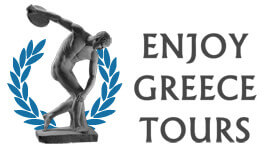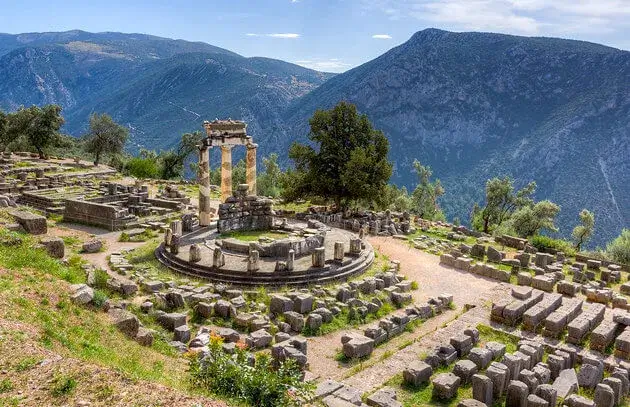Delphi: The Navel of the Ancient World
Delphi was, in antiquity, the centre (the navel or ομϕαλος of the ancient world). It was home to the oracle of Apollo, the sun god. In mythology Apollo is credited with killing the Python which guarded the site that was sacred to Gaia (Mother Earth). The myths say that the Cretans arrived at Delphi’s port, Kirrha, in the company of Apollo who had taken on the form of a dolphin. The myth was reenacted in plays performed in the festivals held at Delphi such as the Pythia, the Theophania, the Delphinia and the Septerion and the Thargelia.
Delphi is located on Mount Parnassos in central Greece, approximately 10 kilometres (8 miles) from the Gulf of Corinth. Myths say that Zeus, the father of the gods, released two eagles from the east and west and had them fly to the centre. They met where Delphi was later built, and their meeting place was marked by a stone, the ομϕαλος.
Delphi has a long history as it was inhabited by the Mycenaeans at some time in the 15th century BC. It was the priests from Knossos, Crete, that took the cult of Apollo to Delphi in the 8th century BC.
In ancient Greece, neighbouring states formed leagues, Amphictyony (amphiktyones), and these were situated around religious centres. The most important of these was the one around Delphi. At first the Delphic Amphictyony comprised the twelve tribes that lived around Thermopylae (the hot gates), the name coming because of the hot springs in the area which were supposed to be the entrance to the underworld (Hades). Here, the religious centre that was in the area was the temple of Demeter, the goddess of agriculture and grain. However, when the league transferred to Delphi, it centred on the temple of Apollo.
The Amphictyonic League in Delphi controlled the finances of the site and the operations of the Delphian sanctuary. The sanctuary became autonomous in the 6th century BC after the First Sacred War. It soon increased its influence, not only in the whole of Greece, but also in much of the known world. It was the centre of the reorganised Pythian Games which were second in importance only to the ancient Olympic games.
From the 6th to the 4th century, the oracle at Delphi was generally regarded as the most trustworthy and it enjoyed the acclaim and fame that was at its peak at that time. Prophesies were delivered by the Pythia, or priestess and given to the priests of Apollo who interpreted the messages direct from the god to the Pythia.
The Pythia’s messages were enigmatic and open to interpretation. One of the messages was given to King Croesus; this said that if Croesus attacked the Persian Empire, a great empire would be lost. Croesus believed that the Persians would lose and attacked. However, it was Croesus who lost his empire.
Treasuries at Delphi
Delphi amassed it wealth by means of the gifts it received in gratitude for prophesies and the gifts made to Apollo. The Athenian treasury has been restored now. It was originally built to give thanks for their naval battle and victory over the Persians in 478 BC and to house their not inconsiderable spoils of war.
The people of Chios built a black marble altar in Delphi in the 5th century BC, which stood in front of the Temple of Apollo.
There are numerous other treasuries at Delphi, all of which once contained untold riches.
No visit to Delphi would be complete without a visit to the archaeological museum at the site. Visitors can marvel at some of the riches discovered at the site and the scenery.
In fact, the area around Delphi is a favourite place of Greeks who want to ski. The resort of nearby Arachova is one of the country’s well-kept secrets, as few foreigners associate Greece with skiing. If you go on a winter tour to Delphi, you may want to stay at one of the many hotels or guesthouses in Arachova.





